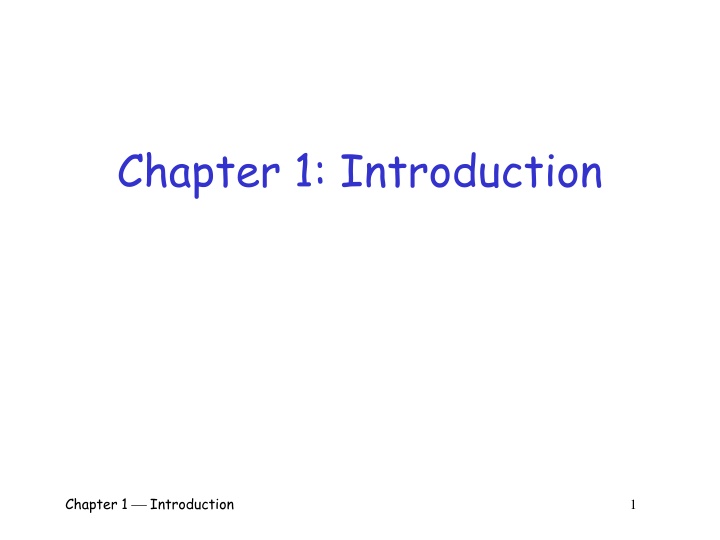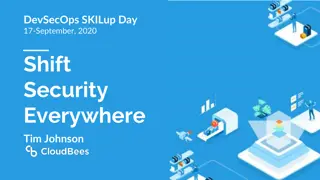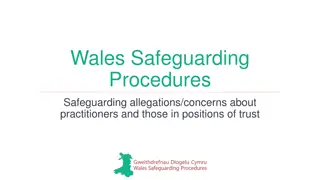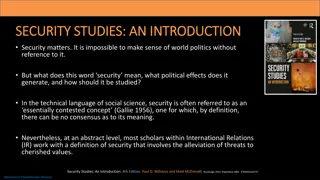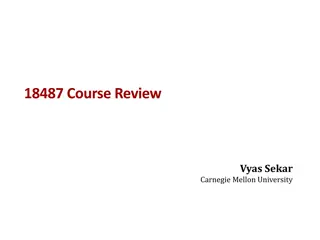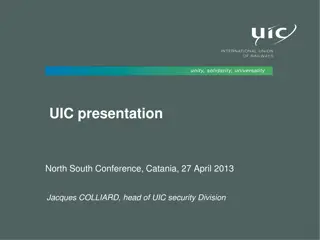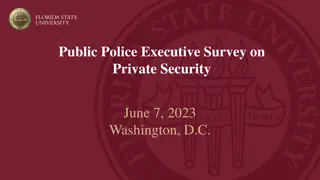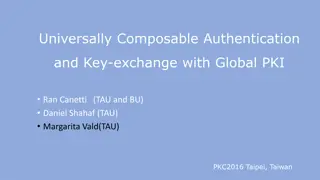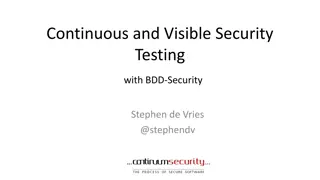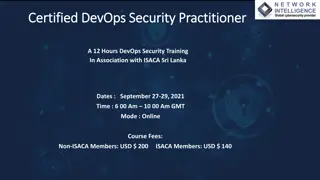Chapter 1: Online Security Concerns
In this introduction, we delve into online security concerns by exploring a scenario involving Alice's Online Bank and the characters Alice, Bob, and Trudy. We discuss the importance of confidentiality, integrity, and availability (CIA) in ensuring security, as well as the use of cryptography to safeguard information. The narrative touches on authentication through passwords and alternatives to enhance security measures.
Download Presentation

Please find below an Image/Link to download the presentation.
The content on the website is provided AS IS for your information and personal use only. It may not be sold, licensed, or shared on other websites without obtaining consent from the author.If you encounter any issues during the download, it is possible that the publisher has removed the file from their server.
You are allowed to download the files provided on this website for personal or commercial use, subject to the condition that they are used lawfully. All files are the property of their respective owners.
The content on the website is provided AS IS for your information and personal use only. It may not be sold, licensed, or shared on other websites without obtaining consent from the author.
E N D
Presentation Transcript
Chapter 1: Introduction Chapter 1 Introduction 1
Organization Lectures Homework o Several homeworks with a few correction sessions Quiz o Several quizzes Mid-term exam Final Exam Grading 2
Exams and Grading Mid-term: 35% Final exam: 40% Homeworkes : 20% Quizzes (bonus): 10% Note: The number of quizzes vastly exceeds the required minimum. There is no replacement for the quizzes. 3
The Cast of Characters Alice and Bob are the good guys Trudy is the bad guy Trudy is our generic intruder Chapter 1 Introduction 4
Alices Online Bank Alice opens Alice s Online Bank (AOB) What are Alice s security concerns? If Bob is a customer of AOB, what are his security concerns? How are Alice s and Bob s concerns similar? How are they different? How does Trudy view the situation? Chapter 1 Introduction 5
CIA CIA == Confidentiality, Integrity, and Availability AOB must prevent Trudy from learning Bob s account balance Confidentiality: prevent unauthorized reading of information o Cryptography used for confidentiality Chapter 1 Introduction 6
CIA Trudy must not be able to change Bob s account balance Bob must not be able to improperly change his own account balance Integrity: detect unauthorized writing of information o Cryptography used for integrity Chapter 1 Introduction 7
CIA AOB s information must be available whenever it s needed Alice must be able to make transaction o If not, she ll take her business elsewhere Availability: Data is available in a timely manner when needed Availability is a new security concern o Denial of service (DoS) attacks Chapter 1 Introduction 8
Beyond CIA: Crypto How does Bob s computer know that Bob is really Bob and not Trudy? Bob s password must be verified o This requires some clever cryptography What are security concerns of pwds? Are there alternatives to passwords? Chapter 1 Introduction 9
Beyond CIA: Protocols When Bob logs into AOB, how does AOB know that Bob is really Bob? As before, Bob s password is verified Unlike the previous case, network security issues arise How do we secure network transactions? o Protocols are critically important o Crypto plays critical role in protocols Chapter 1 Introduction 10
Beyond CIA: Access Control Once Bob is authenticated by AOB, then AOB must restrict actions of Bob o Bob can t view Charlie s account info o Bob can t install new software, etc. Enforcing these restrictions: authorization Access control includes both authentication and authorization Chapter 1 Introduction 11
Beyond CIA: Software Cryptography, protocols, and access control are implemented in software What are security issues of software? o Real world software is complex and buggy o Software flaws lead to security flaws o How does Trudy attack software? o How to reduce flaws in software development? o And what about malware? Chapter 1 Introduction 12
Your Textbook The text consists of four major parts o Cryptography o Access control o Protocols o Software Note: Our focus is on technical issues Chapter 1 Introduction 13
The People Problem People often break security o Both intentionally and unintentionally o Here, we consider the unintentional For example, suppose you want to buy something online o To make it concrete, suppose you want to buy Information Security: Principles and Practice, 2nd edition from amazon.com Chapter 1 Introduction 14
The People Problem To buy from amazon.com o Your Web browser uses SSL protocol o SSL relies on cryptography o Access control issues arise o All security mechanisms are in software Suppose all of this security stuff works perfectly o Then you would be safe, right? Chapter 1 Introduction 15
The People Problem What could go wrong? Trudy tries man-in-the-middle attack o SSL is secure, so attack doesn t work o But, Web browser issues a warning o What do you, the user, do? If user ignores warning, attack works! o None of the security mechanisms failed o But user unintentionally broke security Chapter 1 Introduction 16
Cryptography Secret codes The book covers o Classic cryptography o Symmetric ciphers o Public key cryptography o Hash functions++ o Advanced cryptanalysis Chapter 1 Introduction 17
Access Control Authentication o Passwords o Biometrics o Other methods of authentication Authorization o Access Control Lists/Capabilities o Multilevel security (MLS), security modeling, covert channel, inference control o Firewalls, intrusion detection (IDS) Chapter 1 Introduction 18
Protocols Simple authentication protocols o Focus on basics of security protocols o Lots of applied cryptography in protocols Real-world security protocols o SSH, SSL, IPSec, Kerberos o Wireless: WEP, GSM Chapter 1 Introduction 19
Software Security-critical flaws in software o Buffer overflow o Race conditions, etc. Malware o Examples of viruses and worms o Prevention and detection o Future of malware? Chapter 1 Introduction 20
Software Software reverse engineering (SRE) o How hackers dissect software Software and testing o Open source, closed source, other topics Chapter 1 Introduction 21
Software Operating systems o Basic OS security issues o Trusted OS requirements Software is a BIG security topic o Lots of material to cover o Lots of security problems to consider o But not nearly enough time available Chapter 1 Introduction 22
Think Like Trudy In the past, no respectable sources talked about hacking in detail o After all, such info might help Trudy Recently, this has changed o Lots of books on network hacking, evil software, how to hack software, etc. o Classes teach virus writing, SRE, etc. Chapter 1 Introduction 23
Think Like Trudy Good guys must think like bad guys! A police detective o must study and understand criminals In information security o We want to understand Trudy s methods o Might think about Trudy s motives o We ll often pretend to be Trudy Chapter 1 Introduction 24
Think Like Trudy We must try to think like Trudy We must study Trudy s methods We can admire Trudy s cleverness Often, we can t help but laugh at Alice s and/or Bob s stupidity But, we cannot act like Trudy o Except in this class Chapter 1 Introduction 25
In This Course Think like the bad guy Always look for weaknesses o Find the weak link before Trudy does It s OK to break the rules o What rules? Think like Trudy But don t do anything illegal! Chapter 1 Introduction 26
